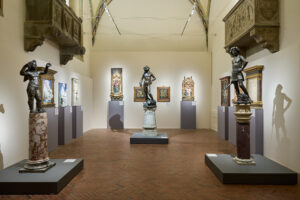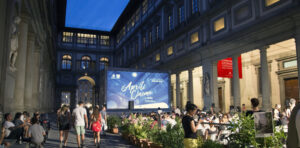Dava Newman vicedirettrice della NASA a Firenze il 12 novembre in occasione di “From Galileo to Mars – Renaissance of the ArtSciences”, simposio organizzato dalla scuola di arte e design SACI con ospiti internazionali.

Biglietti per Marte in offerta per andata e ritorno in giornata. Non passerà molto tempo prima che ci ritroviamo un messaggio pubblicitario del genere nella casella mail. Il pianeta rosso è sempre più vicino: la NASA sta progettando un viaggetto per l’Anno Dominis 2023 e c’è già chi si è spinto a progettare veicoli per l’esplorazione, tute spaziali e perfino strutture pseudoabitative. Già perché le missioni spaziali non sono più patrimonio esclusivo di ingegneri e scienziati, ma sono diventati materia prima per creativi di ogni genere: artisti, designer, architetti. Tanto da far ipotizzare che la missione su Marte possa diventare il punto di partenza per un nuovo Rinascimento. La pensa così la scuola di arte e design SACI Studio Arts College International, che per sabato 12 novembre ha organizzato una giornata intitolata “From Galileo to Mars – Renaissance of the ArtSciences”, proprio per indagare il rapporto tra scienza e arte. La giornata si apre alle 9 al Cinema Odeon di Firenze, con ospiti internazionali tra cui la su citata vicedirettrice Dava Newman, l’astronauta, ingegnere della NASA e artista Nicole Stott, l’astronauta italiano Paolo Nespoli, l’architetto e designer Guillermo Trotti (già progettista di strutture abitative per la luna), l’artista Lia Halloran, autrice della mostra Your Body is a Space that Sees, che sarà allestita per l’occasione a Palazzo dei Cartelloni, in via S. Antonino.
FUL ha intervistato per voi il presidente della SACI, Steven Brittan.
“From Galileo to Mars” sembra il titolo di una canzone o quanto meno di qualcosa che vuol farci sognare, che aspettative ha da questo simposio? E come pensa che la città di Firenze possa recepire tale incontro?
Viaggiare nello spazio e raggiungere Marte sono stati da sempre i sogni della nostra civiltà. Oggi sembra quasi un sogno realizzabile, qualcosa che Galileo non avrebbe mai immaginato. È bello poter ospitare proprio qui a Firenze, dove Galileo visse e fece le sue fondamentali scoperte sull’universo, questo simposio con alcuni degli scienziati più importanti della NASA insieme ad artisti e designer rinomati. La mia speranza è che i fiorentini vengano a condividere questo sogno con noi attraverso le menti dei grandi visionari che ci hanno permesso di far diventare tutto ciò realtà.
È facile immaginare delle relazioni tra arte e scienza, ma spingersi oltre e capire come le due materie possano complementarsi nello sviluppo di missioni spaziali lo è un po’ meno. Ci potrebbe spiegare in che modo ciò sarà possibile?

Questo simposio mostrerà in quanti modi artisti, ingegneri, designer e scienziati collaborano nel risolvere problemi complessi come progettare tute spaziali, veicoli in grado di attraversare terreni irregolari, o costruire strutture e ambienti in grado di resistere a condizioni estreme nello spazio. Ad ogni modo, questo simposio non è dedicato esclusivamente alle scienze spaziali ma vuole dimostrare quanto la collaborazione tra arte e scienza sia efficace nella risoluzione di problemi complessi. Negli ultimi dieci anni il ruolo degli artisti e dei designer è cambiato e non possiamo più pensare di lavorare per compartimenti stagni. Questo simposio è per noi un catalizzatore che deve riaccendere la collaborazione tra arte e scienza a Firenze.
Come sa noi italiani siamo un po’ fissati con il cibo, la sua arte e le sue tradizioni. Crede che anche l’arte culinaria e quindi i grandi chef potranno essere utili nelle future missioni spaziali?
Il nostro pianeta sta vivendo una rivoluzione alimentare e quella di sfamare 8.5 miliardi di persone entro il 2030 è una sfida a dir poco significativa. Credo che i grandi chef si rendano conto che questi problemi vadano affrontati con creatività e hanno già cominciato a inventare nuovi modi per produrre cibo salutare adatto a condizioni ambientali estreme. Comprendere come gli umani si possano adattare ed essere alimentati adeguatamente nei lunghi periodi nello spazio è essenziale. Quindi la risposta è SÌ, io credo che gli chef italiani possano ricoprire un ruolo preziosissimo, nutrendo i nostri astronauti attraverso soluzioni altamente efficienti, nutrienti e artistiche.
Il presidente degli Stati Uniti Barack Obama, in un recente articolo pubblicato sul sito della CNN, ha dichiarato che entro il 2040 gli Stati Uniti sperano di portare un uomo su Marte. Se questo avverrà (e forse anche prima del previsto), quale opera d’arte fiorentina porterebbe sul pianeta rosso?
Forse ti ricorderai di Paulo Nespoli, uno degli astronauti italiani più famosi dell’ESA (che sarà ospite del nostro simposio). Nel 2009 durante la sua missione per riparare il telescopio Hubble, portò con sé una replica del telescopio di Galileo preso in prestito dal Museo Galileo di Firenze, per commemorarne il quattrocentesimo anniversario. Un’opera che potrebbe essere adatta, ma anche ironica, da portare sul pianeta rosso sarebbe il Galileo before the Inquisition (1857) dell’artista toscano Cristiano Banti. Si tratta di una potente ricostruzione della scena del processo, nella quale Galileo si trova in piedi di fronte al Tribunale che tentava di screditare in tutti i modi le sue teorie eliocentriche. Questo dipinto rappresenterebbe un testamento al genio e al coraggio che il giovane Galileo mostrò, incurante del rischio che correva – come quelli dei nostri avventurieri che nel 2040 cercheranno di raggiungere Marte – per il progresso della specie umana e della sua vita sulla terra. •
>>>>ENGLISH VERSION
The red planet is every day closer: NASA is planning a trip for 2023 and there is who has already started to design space-suits and even pseudo-residential structures. Space missions are exclusive to engineers and scientists but a matter for creatives of all type: artists, designers, architects. As far as the mission on Mars can be considered the starting point of a new Renaissance. This is at least what thinks the school of art and design SACI Studio Arts College International, that has organized a symposium called “From Galileo to Mars – Renaissance of the ArtSciences”, on Saturday 12th November.
The day starts at 9.00 at Cinema Odeon in Florence with international guests like Dava Newman,


NASA’s vice director, astronaut, artist and NASA engineer Nicole Stott, the Italian astronaut Paolo Nespoli, the architect and designer Guillermo Trotti, the artist Lia Halloran, author of the exhibition Your Body is a Space that Sees, that will be hosted at Palazzo dei Cartelloni.
FUL interviewed for you, the President of SACI, Steven Brittan.
“From Galileo to Mars” sounds like the title of a song or at the very least something to dream about. What are your expectations for the symposium? How do you think the city of Florence will receive a similar meeting?
It has been civilizations’ long-held dream to travel through space and reach Mars. Now it seems as though we can make it possible, something Galileo may not have imagined. It is poignant that we are hosting this symposium with some of NASA’s leading space scientists, along with renowned artists and designers right here in Florence where Galileo lived and made his profound discoveries about our universe. My hope is that the people of Florence will come share this dream with us through the minds of great visionaries who are paving the way for us to make this a reality.
It’s easy to imagine relationships between art and science, but it’s a bit more difficult to understand how the two can join forces in the development of space missions. Could you explain how this is possible?
This symposium will showcase numerous ways in which artists, engineers, designers and scientist collaborate together, solving complex problems such as designing space-suits to developing vehicles that can traverse rough terrain, or building structures and environments that can withstand extreme conditions in space. This is however not exclusively a symposium about space sciences, instead we want to demonstrate how the collaboration between art and science are much more successful in solving complex problems when combined. In the last decade, the role of artists and designers has changed and we can no longer operate in silo’s. We are looking to this symposium as a catalyst to reignite the collaboration between art and science in Florence.
As you know, we Italians are a bit obsessed with food, its art and its traditions. Do you believe that culinary art and great chefs can be useful in future space missions?
Our planet is undergoing a food revolution and we are significantly challenged for how to feed 8.5 billion people by 2030. I believe great chefs are recognizing that we have to be creative in solving these huge challenges and are already inventing new ways to produce food for extreme conditions in a healthy manner. Understanding how humans can adapt and be properly nourished after extended periods in space is essential. So the answer is YES, I believe Italian chefs can provide an invaluable role, feeding our astronauts with high nutrition in small and most likely artful ways.
U.S. President Barack Obama, in a recent article published on CNN’s website, declared that the United States hopes to have a man on Mars by 2040. If that happens (and if might be even sooner), which Florentine artwork would you take to the red planet?
You may recall that Paulo Nespoli, one of Italy’s renowned astronauts from ESA – who will be speaking at our symposium- on his 2009 space mission to repair the Hubble Space Telescope took with him a replica of Galileo’s telescope on loan from the Galileo Museum in Florence to commemorate Galileo’s 400th anniversary. An artwork that might be both appropriate and ironic to take to the red planet would be by the Tuscan artist Cristiano Banti, Entitled Galileo before the Inquisition (1857), which is a powerful reconstruction of the trial scene where Galileo stands before the Tribunal, doing all they could to dispute his heliocentric theories. This painting would stand as a testament to the genius and courage that young Galileo showed despite the risk to his life – in the same way our adventurers in 2040 will face grave risk to their lives to reach Mars– advancing our human species and our sustainability on earth. •












